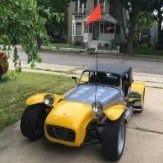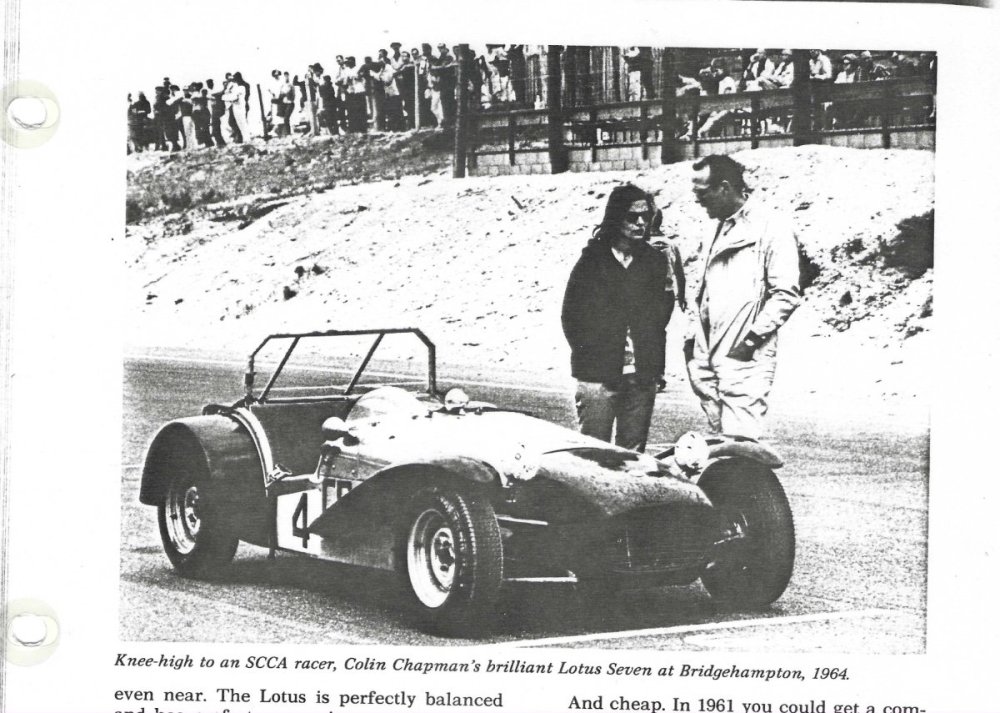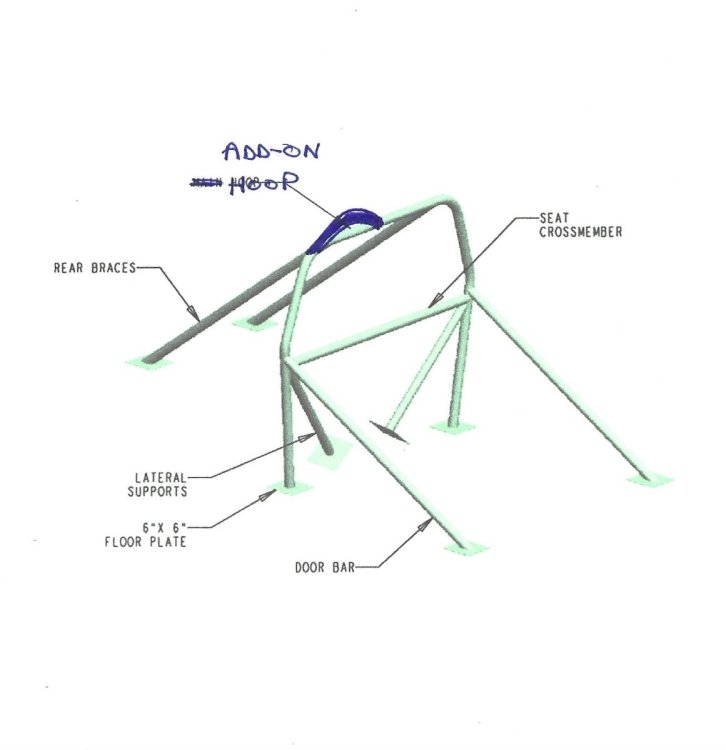
EdWills
Registered User-
Posts
221 -
Joined
-
Hello Christopher. Apologies, but perhaps this ties in with @pethier's unnatural act above?
-
Not sure if this will be helpful and save you a bit of cash, but many years ago a company in the U.K. - John Aley - used to manufacture custom roll bars for many British saloon and open cockpit racing cars. For taller drivers, he would add a curved bar on top of the 'standard'** shape type of roll bar, to cover the driver's head and helmet. I have searched the web, but cannot find any photos of this or any in my collection unfortunately (apparently Aley closed after the death of John Aley - although Rimmer U.K. carry a couple of his examples). The radius of the additional tubing was quite large and not a hoop as such more a 'bump' added on to the existing bar top. Not sure how the roll bar fitted to the Seven shown below passed scrutiny, but in the 60s and 70s from other photos available, roll (over) bars hardly ever protected the top of a driver's head and helmet, often ending below the top of the helmet (even F1, F2 and F3, etc.). W Apologies for the rather crude addition to the drawing, but this is how Aley modified some custom bars.
-
The spec. pages for both the Cosworth BDR engine, and the many parts that Holbay Engineering sold for their engines is now listed under 'Technical' on the website: https://anglocanadianlotus7.ca I am advised that it is in both jpeg and pdf format for free download if it is of interest. JohnCh has been advised, and it may end up in the library. The Cosworth sheets are spoken for and will be on their way to a BDR 7 owner. W.
-
Hi Scott. The son of a friend of ours here in Canada worked for Cosworth in California when the company had a facility there. His mother went through a lot of challenges to get him a green card (had to hire an immigration lawyer), as merely using 'auto mechanic' or 'auto technician' didn't separate him from all of the other men and women in the same occupation. He had originally been hired by Toyota to build racing engines, and finally moved to Indianapolis where he opened his own machine shop building engines for the truck racing category. He suffered a fatal heart attack and his business folded. He provided me with a lot of engine build tips, which I still have in my collection, although I would prefer to leave engine building to the professionals as twice is enough for me (Honda 250cc m/c engine, and Triumph Herald!). W
-
For Canadian 7 owners and just to confirm what many of you may already know, but Aircraft Spruce Canada (Brantford, Ontario) carries all of the same quality hardware that Pegasus in the U.S. carries, at the same or lower list price, but in Canadian Dollars. I like Pegasus, but with the exchange rate between us and the U.S. making it more expensive to purchase hardware for our cars from our neighbour, buying from Aircraft Spruce in Canada is a win-win. I had to wait a few days until some special lock nuts came in to Canada from the U.S. warehouse (so that my order would arrive in one package), but the price was lower than Pegasus, and the shipping by Loomis ground was cheaper than shipping from the U.S. and naturally in $CDN.W
-
- 1
-

-
Just an update. As the BDR is not applicable to a Lotus constructed car, I have finally been able to successfully scan all 18 pages and sent a note to @Croc and @JohnCh for their approval to add the pages to the forum library (the first attempt at scanning probably ended up in the ozone, as I still cannot find them on my computer.!). I will still add the Holbay parts list to my website as time allows. Chris Rees in 'Caterham Sevens' advised that "480 BDR engines have been built to date, and only two remained unfitted to cars at the time of writing (note: my copy published 1996); 331 were 1700s, the remaining 149 being 1600s. Some 400 Cosworths went to Japan" (page 77 in your hymn book). The 1987 Cosworth parts list that I have only mentions the 1600 cc version (1601 cc actual) but in 120, 150, 160 and 170 BHP tune. Rees mentioned weeping cylinder head gaskets, comparatively temperamental running, and carburettor flat-spots (plus being a very expensive engine). As far as effort goes, I've curtailed the riveting on my chassis, and packed up all the tools for the fall and winter. Snow expected this weekend (0 deg. C) + no heated garage! Oh well. W
-
If I'm going to scan 18 pages, I may as well have them added to my website along with the information from Holbay with all of the original parts they offered. I have found a way into my HP printer via a 'back door'. It's slow, but it seems to work so far. The pages are U.K. sized paper, which is longer than North American standard, but just fits on my printer platten. I didn't realize that there was interest in the BDR. According to a Caterham book, there were not that many produced, but some must have made it 'over the pond' to North America. I also do not know if any/many of the parts listed are available anymore? Same with Holbay.? Will advise, and you can then download whatever info. is of use to you. W
-
Hello @wdb. Unfortunately my HP printer/scanner has not kept up with my iMac updates - even with the assistance of HP technical help line, and so I am looking at purchasing a new one. I have received a request from a BDR owner, and the 18 pages of assembly data will be sent to him. If he wishes, perhaps he can add them to this site? Cheers. W.
-
Does anyone on this forum have a Caterham fitted with a Cosworth BDR engine? If so, I have a full set of spec. sheets from 1987 sent to me by Cosworth, that are available free - if you don't mind paying postage (at the lowest rate available from Canada)? Unfortunately, there is a postal strike going on here, but I just thought that I would put the offer out to see if there are any BDR engined cars in North America prior to the strike being settled. You can buzz me a message if you are interested. W.
-
Hi Scott. I was checking out the Holden Vintage (U.K.) web site, and they sell this type of mirror and also variations with curved stem etc. If you can get them to send as noted in another forum, you may not have to pay too much to import them? W.
-
Burton Power U.K. sells a brand new 701M 1500cc Lotus block with the same specs. as the 1600cc block as sold by Ivey, Pegasus, BAT etc. Part No. FL105. 7.8" deck height, bores semi finished to 3.228", 40,000 PSI grey iron, includes cam bearings, upper and lower thrust washer on centre main, etc. L3000.00 Pounds Sterling without tax for export (L3600.00 Sterling in the U.K.) Produced by Ford Racing. With tariffs added on, won't be cheap, but it is available brand new, and stronger than original. Perhaps Ivey or Pegasus can bring one in for you Craig? W
-
Are there many Lotus produced Seven owners on this forum?
EdWills replied to EdWills's topic in General Sevens Discussion
@craig chima. I like the way you have engineered the top suspension link. With your racing rules, are suspension, tires and engine modifications all free choice? W -
Are there many Lotus produced Seven owners on this forum?
EdWills replied to EdWills's topic in General Sevens Discussion
@MV8 I have the same page and totally agree with you. It shows 'Seven Ser. 1 as 93 F, 65 R'. 'Seven Ser. 2 as 95F 54 R.' I also have a 'blow-up' of the page, and the 'Rate 105 in' is actually "RATE lbs in.' The lbs has been lazily written and on my copy is a tad blurred and looks a lot like 105. However, a page from the Armstrong catalogue that was sent to me by one of the members of this forum notes: "Mark 7 Series 1 up to C/No. 1000 1959 - 60, spring rate lbs/inch is 93 front , 65 rear". "Mark 7 Series II and Super 7 1960 the spring rate lbs/inch is 95 front, 50 rear" Tony Weale advised in the appendix to his book that the Series 1 used the same Spax damper and spring combination as the Series 2 and 3 on the front of the car. In an article from a 'Motor Sport' magazine (U.K.), Caterham raced an early Seven built by them and the rate was 105F/75R, but the springs sagged due to manufacturing errors. They then tried 90F/70 R. These spring rates were controlled by rules in the British 1980 Prodsports Championship. The same article advised that for a road-going Caterham 7 (1980-81) fitted with an Ital axle, the rates were 100 F/ 55 R. Later in Series 2 production (and later copied for Series 3), Mick Lincoln, former co-director at Redline, advised me that Lotus changed their specifications to 105 front, 75 rear as standard. DSK (U.S.) used to offer street springs rated at 85F/60 R. Their auto cross springs were 125F/90R. Tom Robertson used 140F, 100R. on his Series 2 race car (1977). Dave Bean recommended 115F/75 rear for standard road use. Mick Beveridge, formerly of Xtra Special Sevens (U.K.), liked 125/11" free length F, with 80/14" free length R. on his road cars, but noted that most companies in the U.K. don't make the 80s, so he went to 100 lbs/inch with 14 inch free length. W. -
Are there many Lotus produced Seven owners on this forum?
EdWills replied to EdWills's topic in General Sevens Discussion
Hi Scott. I think the magazine writer also got the spring rate numbers for the basic Seven Series 2 and 3 wrong. They were originally 105lbs on the front and 75lbs on the rear (o.k. we'll give them 80!) @SENC very kindly sent me a list of Armstrong dampers and springs a while back from an old catalogue. Not sure if they are in the library though? W. My wife thinks that I am lotus intolerant. I think she meant to say lactose, but either way seems to fit! -
Are there many Lotus produced Seven owners on this forum?
EdWills replied to EdWills's topic in General Sevens Discussion
If you can purchase a copy of the late Dennis Ortenburger's book "Legend of the Lotus Seven" (or perhaps you have one already?) he has a chapter on some racing Sevens and their owners in the U.S., one of them being Tom Robertson who ran a Series 2. His Seven had fairly soft springing, beefed up chassis frame, spherical joints on suspension arms, Spitfire diff. nose piece and TR7 axles. The engine was the 116E over-bored with dry-sump. He also used adjustable anti-roll bars front and rear as @craig chima recommends. Robertson was able to make use of Goodyear Formula Ford tires, which heavier cars could not use. He beat the works Triumph TR7 team to take the Class 'D' Championship (1977) even after an appeal was launched by Triumph over the use of the nose piece. Ortenburger features other U.S. racing Sevens in his book, and I wonder where they are now? Reading stories out of the U.K. and the U.S., it reveals that the Lotus Seven has often (always?) been placed at a deliberate disadvantage by being classed in racing categories with cars that were way over the top in terms of power and engine capacity. Even so, the Lotus Seven gave them a run for their money. It probably gave Colin Chapman a good chuckle too, even though he had really lost interest in the car. Thank you Craig for all the information..




